Fiducial Reference Measurements for Greenhouse Gases (FRM4GHG): Validation of Satellite (Sentinel-5 Precursor, OCO-2, and GOSAT) Missions Using the COllaborative Carbon Column Observing Network (COCCON)
Abstract
1. Introduction
2. Materials and Methods
2.1. Sentinel-5 Precursor Mission Overview
2.2. OCO-2 Mission Overview
2.3. GOSAT Mission Overview
2.4. Ground-Based COCCON Reference Data
3. Results
3.1. Sentinel-5 Precursor Validation
3.1.1. S5P XCH4 Validation Results
3.1.2. S5P XCO Validation Results
3.2. OCO-2 Validation
3.3. GOSAT Validation
3.3.1. GOSAT XCO2 Validation Results
3.3.2. GOSAT XCH4 Validation Results
4. Discussion and Outlook
Author Contributions
Funding
Data Availability Statement
Acknowledgments
Conflicts of Interest
References
- Sha, M.K.; De Mazière, M.; Notholt, J.; Blumenstock, T.; Bogaert, P.; Cardoen, P.; Chen, H.; Desmet, F.; García, O.; Griffith, D.W.T.; et al. Fiducial reference measurement for greenhouse gases (frm4ghg). Remote Sens. 2024, 16, 3525. [Google Scholar] [CrossRef]
- Wunch, D.; Toon, G.C.; Blavier, J.-F.L.; Washenfelder, R.A.; Notholt, J.; Connor, B.J.; Griffith, D.W.T.; Sherlock, V.; Wennberg, P.O. The total carbon column observing network. Philos. Trans. R. Soc. A Math. Phys. Eng. Sci. 2011, 369, 2087–2112. [Google Scholar] [CrossRef] [PubMed]
- De Mazière, M.; Thompson, A.M.; Kurylo, M.J.; Wild, J.D.; Bernhard, G.; Blumenstock, T.; Braathen, G.O.; Hannigan, J.W.; Lambert, J.-C.; Leblanc, T.; et al. The network for the detection of atmospheric composition change (NDACC): History, status and perspectives. Atmos. Chem. Phys. 2018, 18, 4935–4964. [Google Scholar] [CrossRef]
- Kuze, A.; Suto, H.; Nakajima, M.; Hamazaki, T. Thermal and near infrared sensor for carbon observation Fourier-transform spectrometer on the greenhouse gases observing satellite for greenhouse gases monitoring. Appl. Opt. 2009, 48, 6716–6733. [Google Scholar] [CrossRef]
- Yokota, T.; Yoshida, Y.; Eguchi, N.; Ota, Y.; Tanaka, T.; Watanabe, H.; Maksyutov, S. Global concentrations of CO2 and CH4 retrieved from GOSAT: First preliminary results. SOLA 2009, 5, 160–163. [Google Scholar] [CrossRef]
- Veefkind, J.P.; Aben, I.; McMullan, K.; Förster, H.; de Vries, J.; Otter, G.; Claas, J.; Eskes, H.J.; de Haan, J.F.; Kleipool, Q.; et al. TROPOMI on the ESA sentinel-5 precursor: A GMES mission for global observations of the atmospheric composition for climate, air quality and ozone layer applications. Remote Sens. Environ. 2012, 120, 70–83. [Google Scholar] [CrossRef]
- Hu, H.; Hasekamp, O.; Butz, A.; Galli, A.; Landgraf, J.; de Brugh, J.A.; Borsdorff, T.; Scheepmaker, R.; Aben, I. The operational methane retrieval algorithm for tropomi. Atmos. Meas. Tech. 2016, 9, 5423–5440. [Google Scholar] [CrossRef]
- Hasekamp, O.; Lorente, A.; Hu, H.; Butz, A.; aan de Brugh, J.; Landgraf, J. Algorithm Theoretical Baseline Document for Sentinel-5 Precursor Methane Retrieval. 2022. Available online: https://sentinels.copernicus.eu/documents/247904/2476257/Sentinel-5P-TROPOMI-ATBD-Methane-retrieval.pdf/ (accessed on 1 March 2024).
- ESA-EOPG-CSCOP-PL. Sentinel-5 Precursor Calibration and Validation Plan for the Operational Phase, 2017-11-06. Available online: https://sentinel.esa.int/documents/247904/2474724/Sentinel-5P-Calibration-and-Validation-Plan.pdf (accessed on 1 March 2024).
- Landgraf, J.; aan de Brugh, J.; Scheepmaker, R.; Borsdorff, T.; Houweling, S.; Hasekamp, O. Algorithm Theoretical Baseline Document for Sentinel-5 Precursor: Carbon Monoxide Total Column Retrieval. 2022. Available online: https://sentinels.copernicus.eu/documents/247904/2476257/Sentinel-5P-TROPOMI-ATBD-Carbon-Monoxide-Total-Column-Retrieval.pdf/ (accessed on 1 March 2024).
- Lambert, J.-C.; Keppens, A.; Compernolle, S.; Eichmann, K.-U.; de Graaf, M.; Hubert, D.; Langerock, B.; Ludewig, A.; Sha, M.K.; Verhoelst, T.; et al. Quarterly Validation Report of the Copernicussentinel-5 Precursor Operational Data Products #23: April2018 to May2024. 2024. Available online: https://mpc-vdaf.tropomi.eu/ProjectDir/reports//pdf/S5P-MPC-IASB-ROCVR-23.00.00_FINAL_signed.pdf (accessed on 1 March 2024).
- Borsdorff, T.; aan de Brugh, J.; Schneider, A.; Lorente, A.; Birk, M.; Wagner, G.; Kivi, R.; Hase, F.; Feist, D.G.; Sussmann, R.; et al. Improving the TROPOMI CO data product: Update of the spectroscopic database and destriping of single orbits. Atmos. Meas. Tech. 2019, 12, 5443–5455. [Google Scholar] [CrossRef]
- Crisp, D.; Miller, C.E.; DeCola, P.L. NASA Orbiting Carbon Observatory: Measuring the column averaged carbon dioxide mole fraction from space. J. Appl. Remote Sens. 2008, 2, 023508. [Google Scholar] [CrossRef]
- Crisp, D. Measuring atmospheric carbon dioxide from space with the Orbiting Carbon Observatory-2 (OCO-2). In Earth Observing Systems XX; Butler, J.J., Xiong, X., Gu, X., Eds.; International Society for Optics and Photonics, SPIE: San Diego, CA, USA, 2015; Volume 9607, p. 960702. [Google Scholar] [CrossRef]
- Crisp, D.; Pollock, H.R.; Rosenberg, R.; Chapsky, L.; Lee, R.A.M.; Oyafuso, F.A.; Frankenberg, C.; O’Dell, C.W.; Bruegge, C.J.; Doran, G.B.; et al. The on-orbit performance of the orbiting carbon Observatory-2 (OCO-2) instrument and its radiometrically calibrated products. Atmos. Meas. Tech. 2017, 10, 59–81. [Google Scholar] [CrossRef]
- Crowell, S.; Baker, D.; Schuh, A.; Basu, S.; Jacobson, A.R.; Chevallier, F.; Liu, J.; Deng, F.; Feng, L.; McKain, K.; et al. The 2015–2016 carbon cycle as seen from OCO-2 and the global in situ network. Atmos. Chem. Phys. 2019, 19, 9797–9831. [Google Scholar] [CrossRef]
- David Crisp and the OCO-2 Team. Measuring atmospheric carbon dioxide from space: The GOSAT and OCO-2 missions. In Renewable Energy and the Environment; Optica Publishing Group: Austin, TX, USA, 2011; p. EWC6. [Google Scholar] [CrossRef]
- Keppel-Aleks, G.; Wennberg, P.O.; Schneider, T. Sources of variations in total column carbon dioxide. Atmos. Chem. Phys. 2011, 11, 3581–3593. [Google Scholar] [CrossRef]
- Eldering, A.; O’Dell, C.W.; Wennberg, P.O.; Crisp, D.; Gunson, M.R.; Viatte, C.; Avis, C.; Braverman, A.; Castano, R.; Chang, A.; et al. The orbiting carbon observatory-2: First 18 months of science data products. Atmos. Meas. Tech. 2017, 10, 549–563. [Google Scholar] [CrossRef]
- Connor, B.J.; Boesch, H.; Toon, G.; Sen, B.; Miller, C.; Crisp, D. Orbiting carbon observatory: Inverse method and prospective error analysis. J. Geophys. Res. Atmos. 2008, 113. [Google Scholar] [CrossRef]
- O’Dell, C.W.; Connor, B.; Bösch, H.; O’Brien, D.; Frankenberg, C.; Castano, R.; Christi, M.; Eldering, D.; Fisher, B.; Gunson, M.; et al. The ACOS CO2 retrieval algorithm—Part 1: Description and validation against synthetic observations. Atmos. Meas. Tech. 2012, 5, 99–121. [Google Scholar] [CrossRef]
- O’Dell, C.W.; Eldering, A.; Wennberg, P.O.; Crisp, D.; Gunson, M.R.; Fisher, B.; Frankenberg, C.; Kiel, M.; Lindqvist, H.; Mandrake, L.; et al. Improved retrievals of carbon dioxide from orbiting carbon observatory-2 with the version 8 ACOS algorithm. Atmos. Meas. Tech. 2018, 11, 6539–6576. [Google Scholar] [CrossRef]
- Jacobs, N.; O’Dell, C.W.; Taylor, T.E.; Logan, T.L.; Byrne, B.K.; Kiel, M.; Kivi, R.; Heikkinen, P.; Merrelli, A.; Payne, V.H.; et al. The importance of digital elevation model accuracy in XCO2 retrievals: Improving the OCO-2 ACOS v11 product. Atmos. Meas. Tech. Discuss. 2023, 17, 1375–1401. [Google Scholar] [CrossRef]
- Someya, Y.; Yoshida, Y.; Ohyama, H.; Nomura, S.; Kamei, A.; Morino, I.; Mukai, H.; Matsunaga, T.; Laughner, J.L.; Velazco, V.A.; et al. Update on the GOSAT TANSO–FTS SWIR level 2 retrieval algorithm. Atmos. Meas. Tech. 2023, 16, 1477–1501. [Google Scholar] [CrossRef]
- Yoshida, Y.; Ota, Y.; Eguchi, N.; Kikuchi, N.; Nobuta, K.; Tran, H.; Morino, I.; Yokota, T. Retrieval algorithm for CO2 and CH4 column abundances from short-wavelength infrared spectral observations by the greenhouse gases observing satellite. Atmos. Meas. Tech. 2011, 4, 717–734. [Google Scholar] [CrossRef]
- Hase, F.; Frey, M.; Kiel, M.; Blumenstock, T.; Harig, R.; Keens, A.; Orphal, J. Addition of a channel for XCO observations to a portable FTIR spectrometer for greenhouse gas measurements. Atmos. Meas. Tech. 2016, 9, 2303–2313. [Google Scholar] [CrossRef]
- Sha, M.K.; De Mazière, M.; Notholt, J.; Blumenstock, T.; Chen, H.; Dehn, A.; Griffith, D.W.T.; Hase, F.; Heikkinen, P.; Hermans, C.; et al. Intercomparison of low- and high-resolution infrared spectrometers for ground-based solar remote sensing measurements of total column concentrations of CO2, CH4, and CO. Atmos. Meas. Tech. 2020, 13, 4791–4839. [Google Scholar] [CrossRef]
- Frey, M.; Sha, M.K.; Hase, F.; Kiel, M.; Blumenstock, T.; Harig, R.; Surawicz, G.; Deutscher, N.M.; Shiomi, K.; Franklin, J.E.; et al. Building the collaborative carbon column observing network (COCCON): Long-term stability and ensemble performance of the EM27/SUN Fourier transform spectrometer. Atmos. Meas. Tech. 2019, 12, 1513–1530. [Google Scholar] [CrossRef]
- Feld, L.; Herkommer, B.; Vestner, J.; Dubravica, D.; Alberti, C.; Hase, F. Proffastpylot: Running proffast with python. J. Open Source Softw. 2024, 9, 6481. [Google Scholar] [CrossRef]
- Pollard, D.F.; Hase, F.; Sha, M.K.; Dubravica, D.; Alberti, C.; Smale, D. Retrievals of XCO2, XCH4 and XCO from portable, near-infrared Fourier transform spectrometer solar observations in antarctica. Earth Syst. Sci. Data 2022, 14, 5427–5437. [Google Scholar] [CrossRef]
- Alberti, C.; Tu, Q.; Hase, F.; Makarova, M.V.; Gribanov, K.; Foka, S.C.; Zakharov, V.; Blumenstock, T.; Buchwitz, M.; Diekmann, C.; et al. Investigation of spaceborne trace gas products over St Petersburg and Yekaterinburg, Russia, by using collaborative column carbon observing network (COCCON) observations. Atmos. Meas. Tech. 2022, 15, 2199–2229. [Google Scholar] [CrossRef]
- Jacobs, N.; Simpson, W.R.; Wunch, D.; O’Dell, C.W.; Osterman, G.B.; Hase, F.; Blumenstock, T.; Tu, Q.; Frey, M.; Dubey, M.K.; et al. Quality controls, bias, and seasonality of CO2 columns in the boreal forest with orbiting carbon observatory-2, total carbon column observing network, and EM27/SUN measurements. Atmos. Meas. Tech. 2020, 13, 5033–5063. [Google Scholar] [CrossRef]
- Pak, N.M.; Hedelius, J.K.; Roche, S.; Cunningham, L.; Baier, B.; Sweeney, C.; Roehl, C.; Laughner, J.; Toon, G.; Wennberg, P.; et al. Using portable low-resolution spectrometers to evaluate total carbon column observing network (TCCON) biases in North America. Atmos. Meas. Tech. 2023, 16, 1239–1261. [Google Scholar] [CrossRef]
- Mermigkas, M.; Topaloglou, C.; Balis, D.; Koukouli, M.E.; Hase, F.; Dubravica, D.; Borsdorff, T.; Lorente, A. FTIR measurements of greenhouse gases over Thessaloniki, Greece in the framework of COCCON and comparison with S5P/TROPOMI observations. Remote Sensing 2021, 13, 3395. [Google Scholar] [CrossRef]
- Zhou, M.; Ni, Q.; Cai, Z.; Langerock, B.; Nan, W.; Yang, Y.; Che, K.; Yang, D.; Wang, T.; Liu, Y.; et al. CO2 in Beijing and Xianghe observed by ground-based FTIR column measurements and validation to OCO-2/3 satellite observations. Remote Sens. 2022, 14, 3769. [Google Scholar] [CrossRef]
- Rißmann, M.; Chen, J.; Osterman, G.; Zhao, X.; Dietrich, F.; Makowski, M.; Hase, F.; Kiel, M. Comparison of OCO-2 target observations to MUCCnet—Is it possible to capture urban XCO2 gradients from space? Atmos. Meas. Tech. 2022, 15, 6605–6623. [Google Scholar] [CrossRef]
- Dietrich, F.; Chen, J.; Voggenreiter, B.; Aigner, P.; Nachtigall, N.; Reger, B. MUCCnet: Munich urban carbon column network. Atmos. Meas. Tech. 2021, 14, 1111–1126. [Google Scholar] [CrossRef]
- Che, K.; Lauvaux, T.; Taquet, N.; Stremme, W.; Xu, Y.; Alberti, C.; Lopez, M.; García-Reynoso, A.; Ciais, P.; Liu, Y.; et al. CO2 emissions estimate from Mexico city using ground- and space-based remote sensing. J. Geophys. Res. Atmos. 2024, 129, e2024JD041297. [Google Scholar] [CrossRef]
- Taquet, N.; Stremme, W.; del Castillo, M.E.G.; Almanza, V.; Bezanilla, A.; Laurent, O.; Alberti, C.; Hase, F.; Ramonet, M.; Lauvaux, T.; et al. CO2 and CO temporal variability over Mexico city from ground-based total column and surface measurements. Atmos. Chem. Phys. 2024, 24, 11823–11848. [Google Scholar] [CrossRef]
- Che, K.; Lauvaux, T.; Taquet, N.; Stremme, W.; Xu, Y.; Alberti, C.; Lopez, M.; García-Reynoso, A.; Ciais, P.; Liu, Y.; et al. Urban XCO2 gradients from a dense network of solar absorption spectrometers and OCO-3 over Mexico city. J. Geophys. Res. Atmos. 2024, 129, e2023JD040063. [Google Scholar] [CrossRef]
- Frey, M.M.; Hase, F.; Blumenstock, T.; Dubravica, D.; Groß, J.; Göttsche, F.; Handjaba, M.; Amadhila, P.; Mushi, R.; Morino, I.; et al. Long-term column-averaged greenhouse gas observations using a COCCON spectrometer at the high-surface-albedo site in Gobabeb, Namibia. Atmos. Meas. Tech. 2021, 14, 5887–5911. [Google Scholar] [CrossRef]
- Humpage, N.; Boesch, H.; Okello, W.; Chen, J.; Dietrich, F.; Lunt, M.F.; Feng, L.; Palmer, P.I.; Hase, F. Greenhouse gas column observations from a portable spectrometer in Uganda. Atmos. Meas. Tech. 2024, 17, 5679–5707. [Google Scholar] [CrossRef]
- Lorente, A.; Borsdorff, T.; Butz, A.; Hasekamp, O.; de Brugh, J.A.; Schneider, A.; Wu, L.; Hase, F.; Kivi, R.; Wunch, D.; et al. Methane retrieved from TROPOMI: Improvement of the data product and validation of the first 2 years of measurements. Atmos. Meas. Tech. 2021, 14, 665–684. [Google Scholar] [CrossRef]
- Sha, M.K.; Langerock, B.; Blavier, J.-F.L.; Blumenstock, T.; Borsdorff, T.; Buschmann, M.; Dehn, A.; De Mazière, M.; Deutscher, N.M.; Feist, D.G.; et al. Validation of methane and carbon monoxide from sentinel-5 precursor using TCCON and NDACC-IRWG stations. Atmos. Meas. Tech. 2021, 14, 6249–6304. [Google Scholar] [CrossRef]
- Rodgers, C.D.; Connor, B.J. Intercomparison of remote sounding instruments. J. Geophys. Res. Atmos. 2003, 108. [Google Scholar] [CrossRef]
- Wunch, D.; Wennberg, P.O.; Osterman, G.; Fisher, B.; Naylor, B.; Roehl, C.M.; O’Dell, C.; Mandrake, L.; Viatte, C.; Kiel, M.; et al. Comparisons of the orbiting carbon observatory-2 (OCO-2) XCO2 measurements with TCCON. Atmos. Meas. Tech. 2017, 10, 2209–2238. [Google Scholar] [CrossRef]
- Hall, B.D.; Crotwell, A.M.; Kitzis, D.R.; Mefford, T.; Miller, B.R.; Schibig, M.F.; Tans, P.P. Revision of the world meteorological organization global atmosphere watch (WMO/GAW) CO2 calibration scale. Atmos. Meas. Tech. 2021, 14, 3015–3032. [Google Scholar] [CrossRef]
- Morino, I.; Uchino, O.; Inoue, M.; Yoshida, Y.; Yokota, T.; Wennberg, P.O.; Toon, G.C.; Wunch, D.; Roehl, C.M.; Notholt, J.; et al. Preliminary validation of column-averaged volume mixing ratios of carbon dioxide and methane retrieved from GOSAT short-wavelength infrared spectra. Atmos. Meas. Tech. 2011, 4, 1061–1076. [Google Scholar] [CrossRef]
- Velazco, V.A.; Deutscher, N.M.; Morino, I.; Uchino, O.; Bukosa, B.; Ajiro, M.; Kamei, A.; Jones, N.B.; Paton-Walsh, C.; Griffith, D.W.T. Satellite and ground-based measurements of XCO2 in a remote semiarid region of Australia. Earth Syst. Sci. Data 2019, 11, 935–946. [Google Scholar] [CrossRef]
- Wunch, D.; Laughner, J.; Toon, G.C.; Roehl, C.M.; Wennberg, P.O.; Millán, L.F.; Deutscher, N.M.; Warneke, T.; Pollard, D.F.; Feist, D.G.; et al. The Total Carbon Column Observing Network’s GGG2020 Data Version: Data Quality, Comparison with GGG2014, and Future Outlook. CaltechDATA 2025. [Google Scholar] [CrossRef]
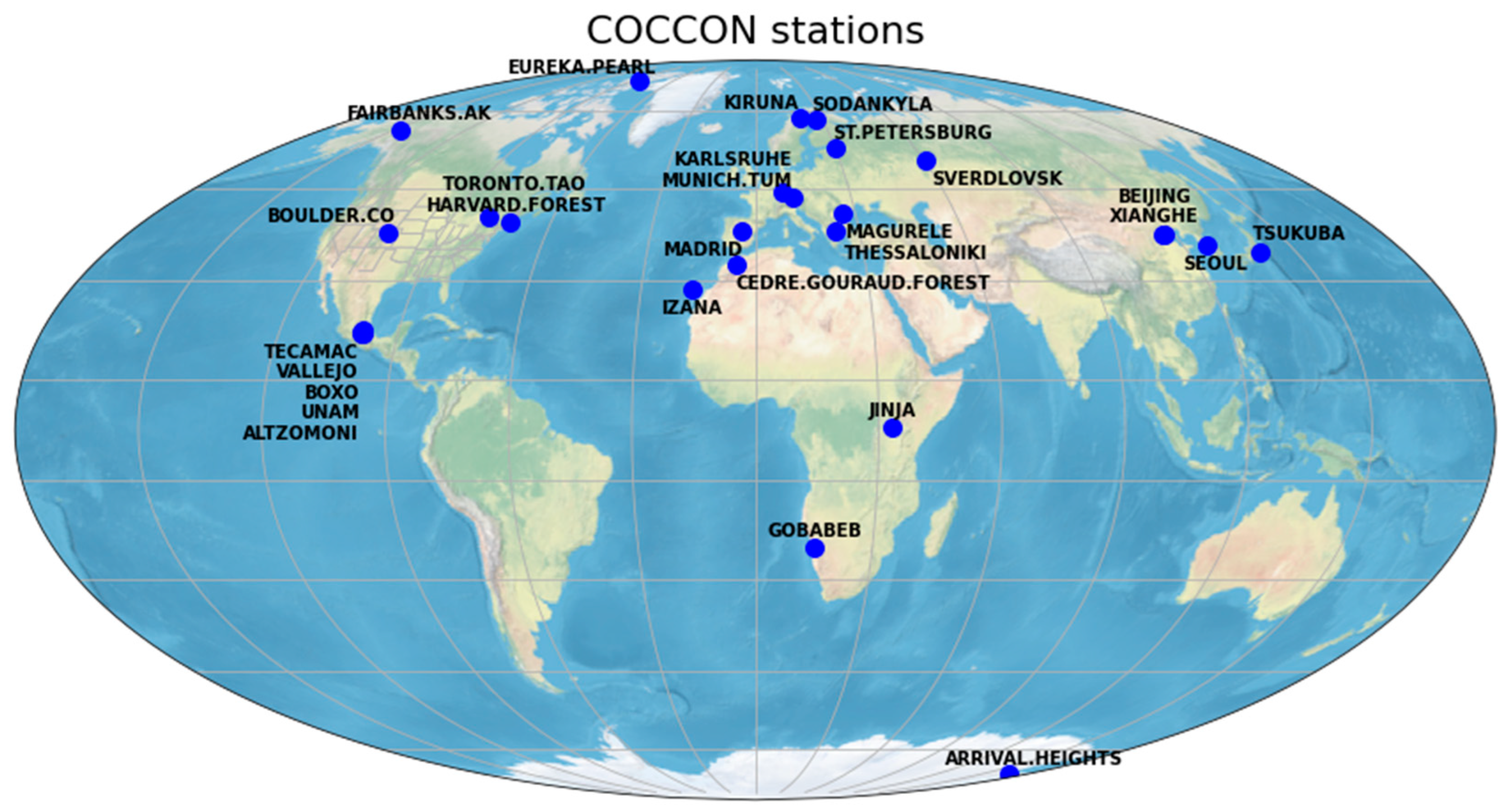
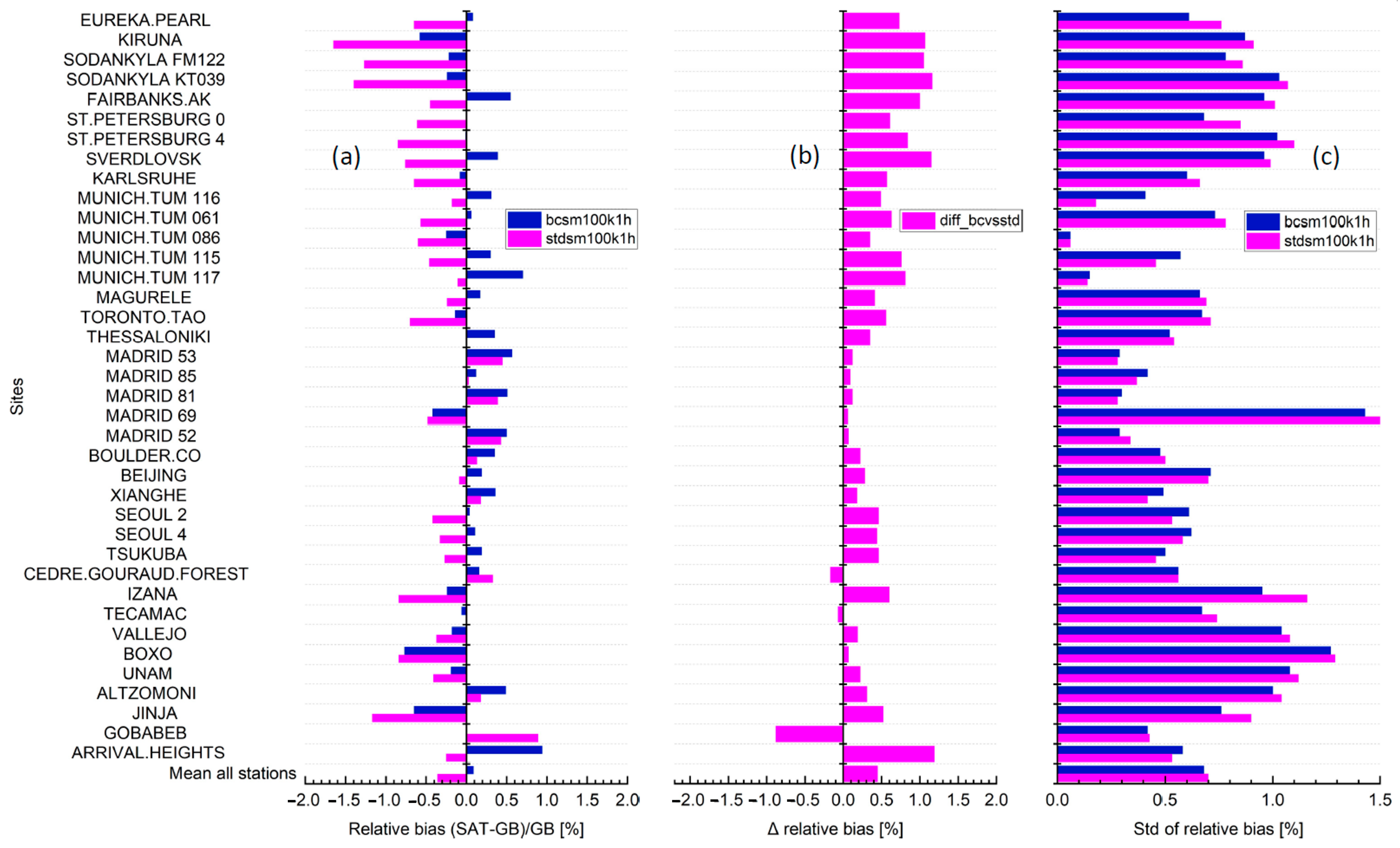
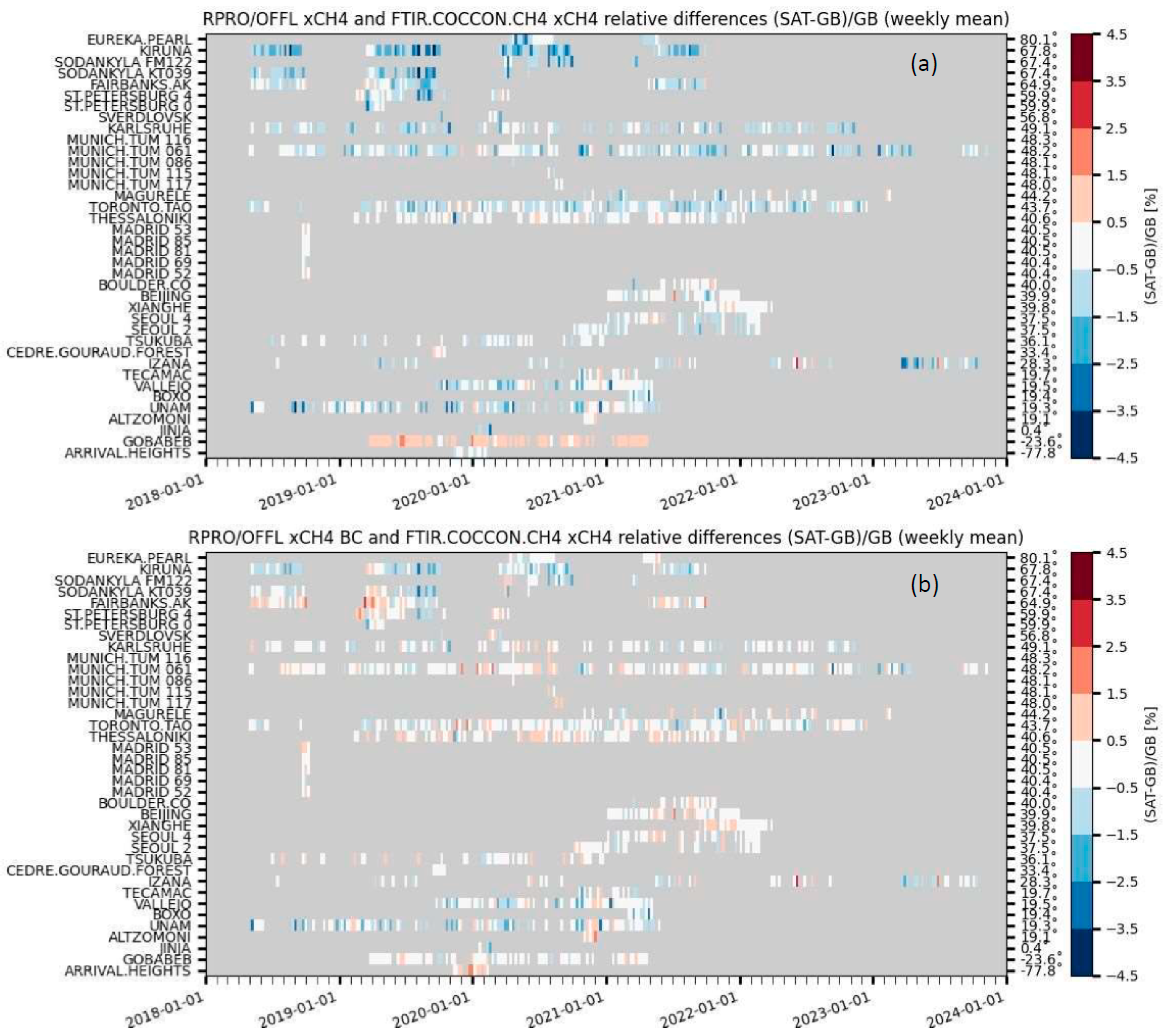
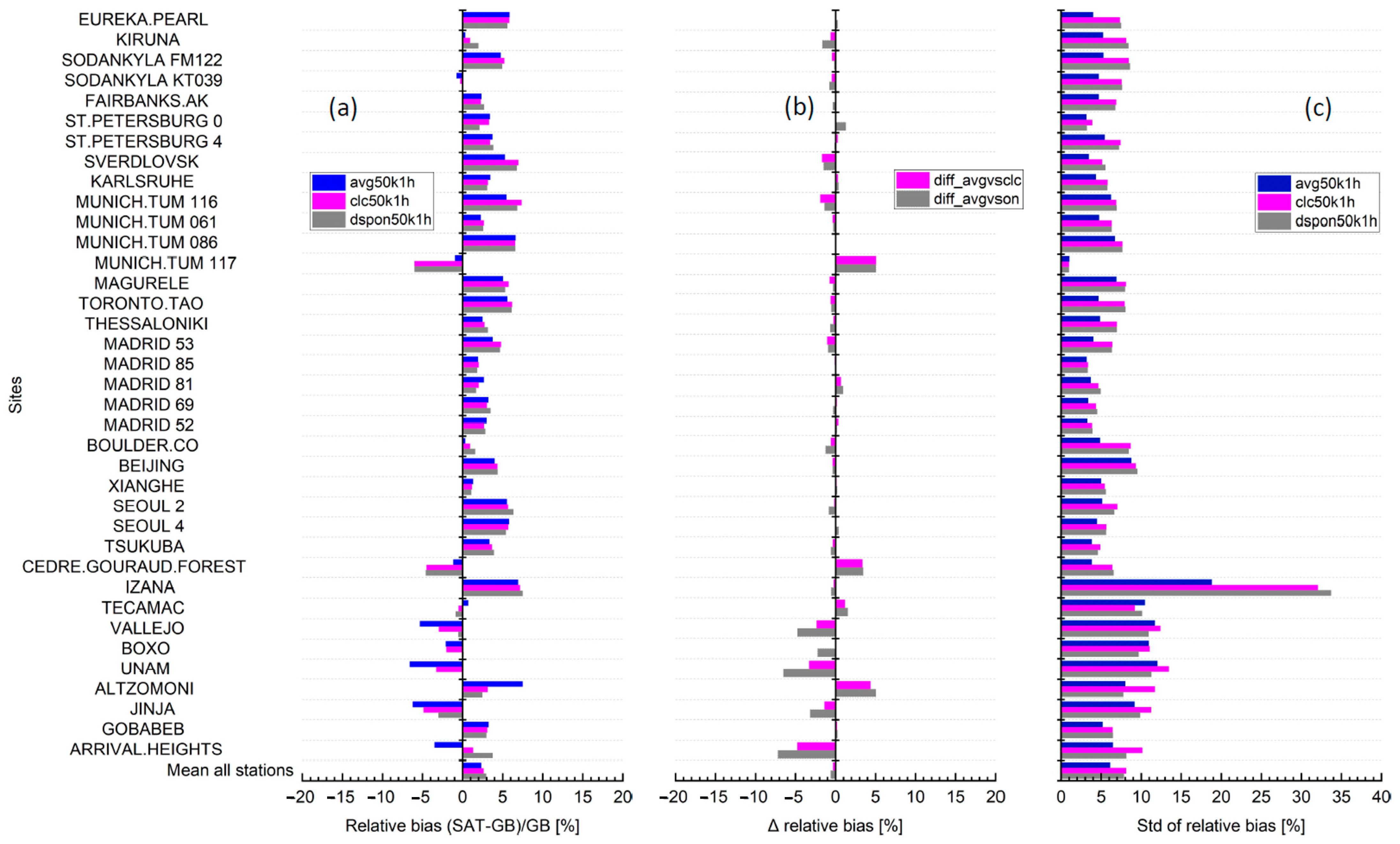
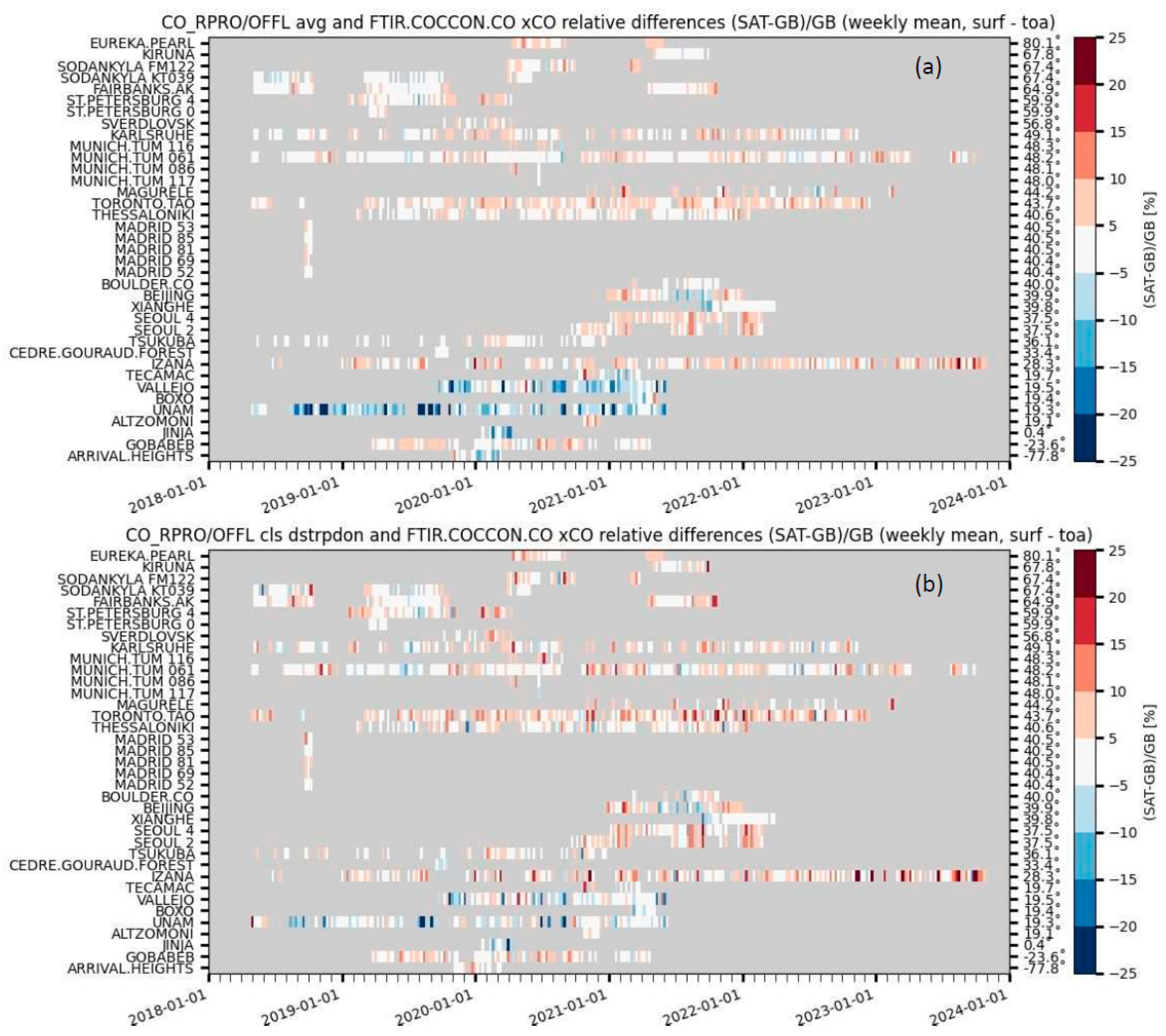

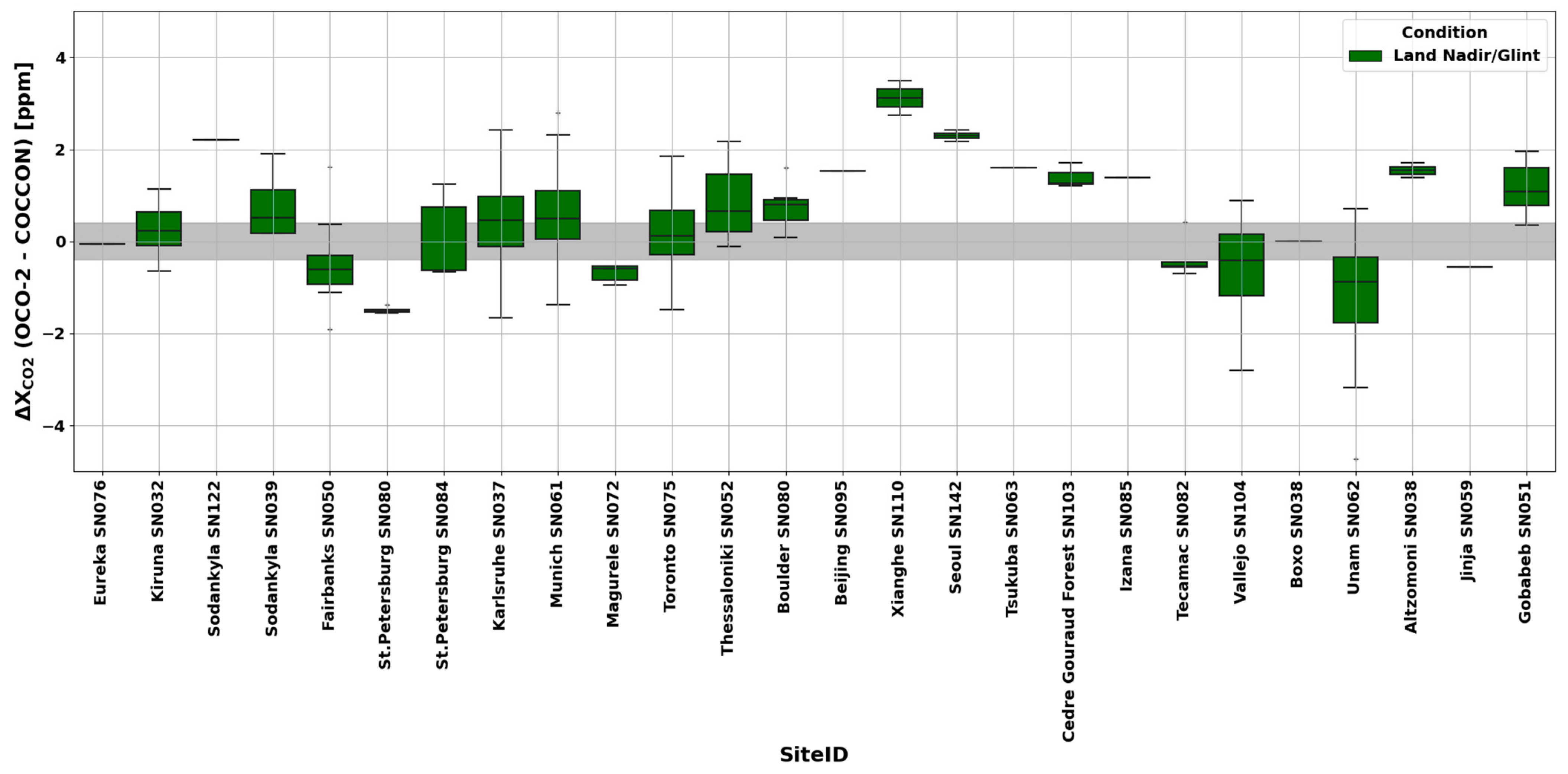
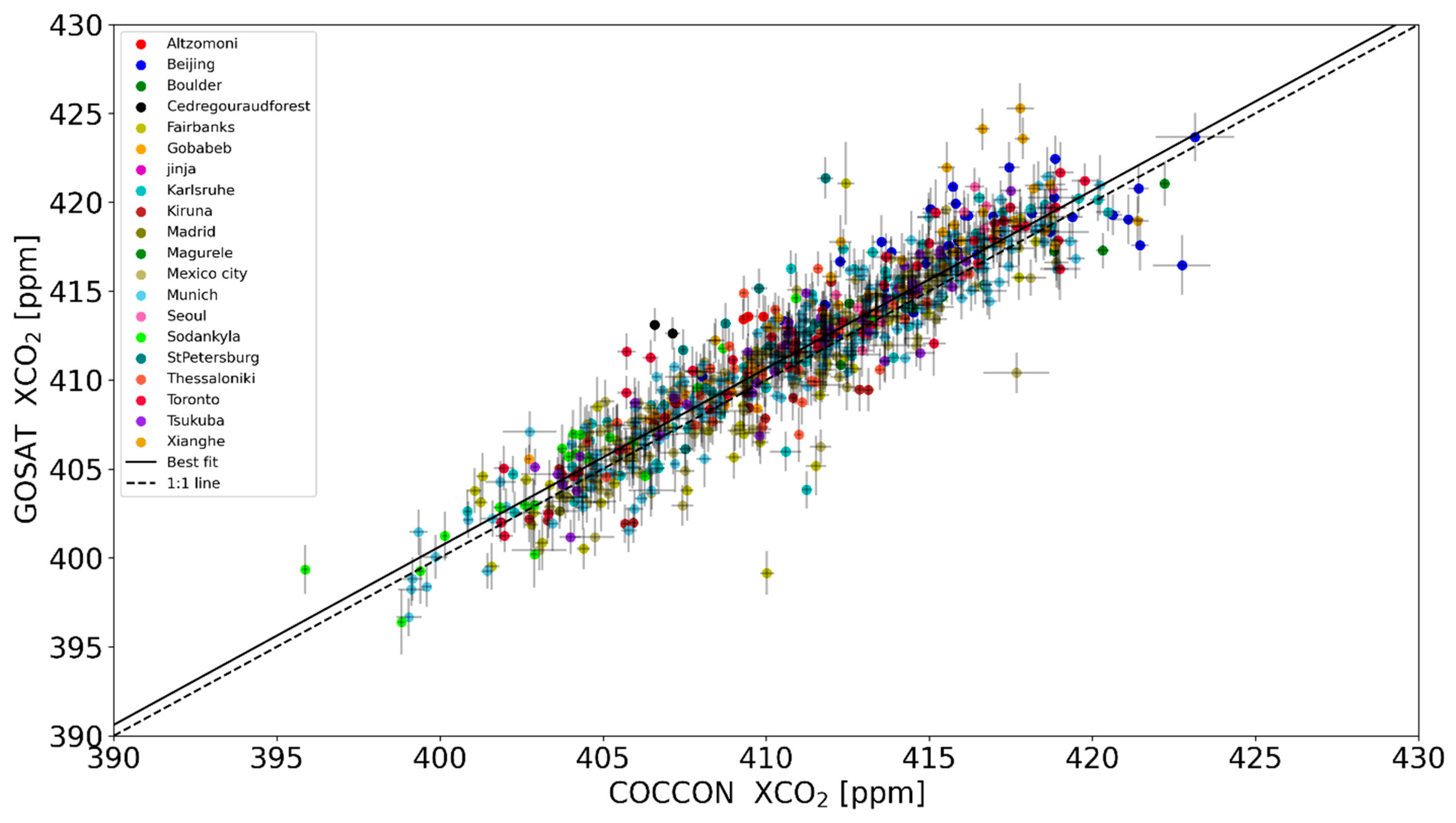
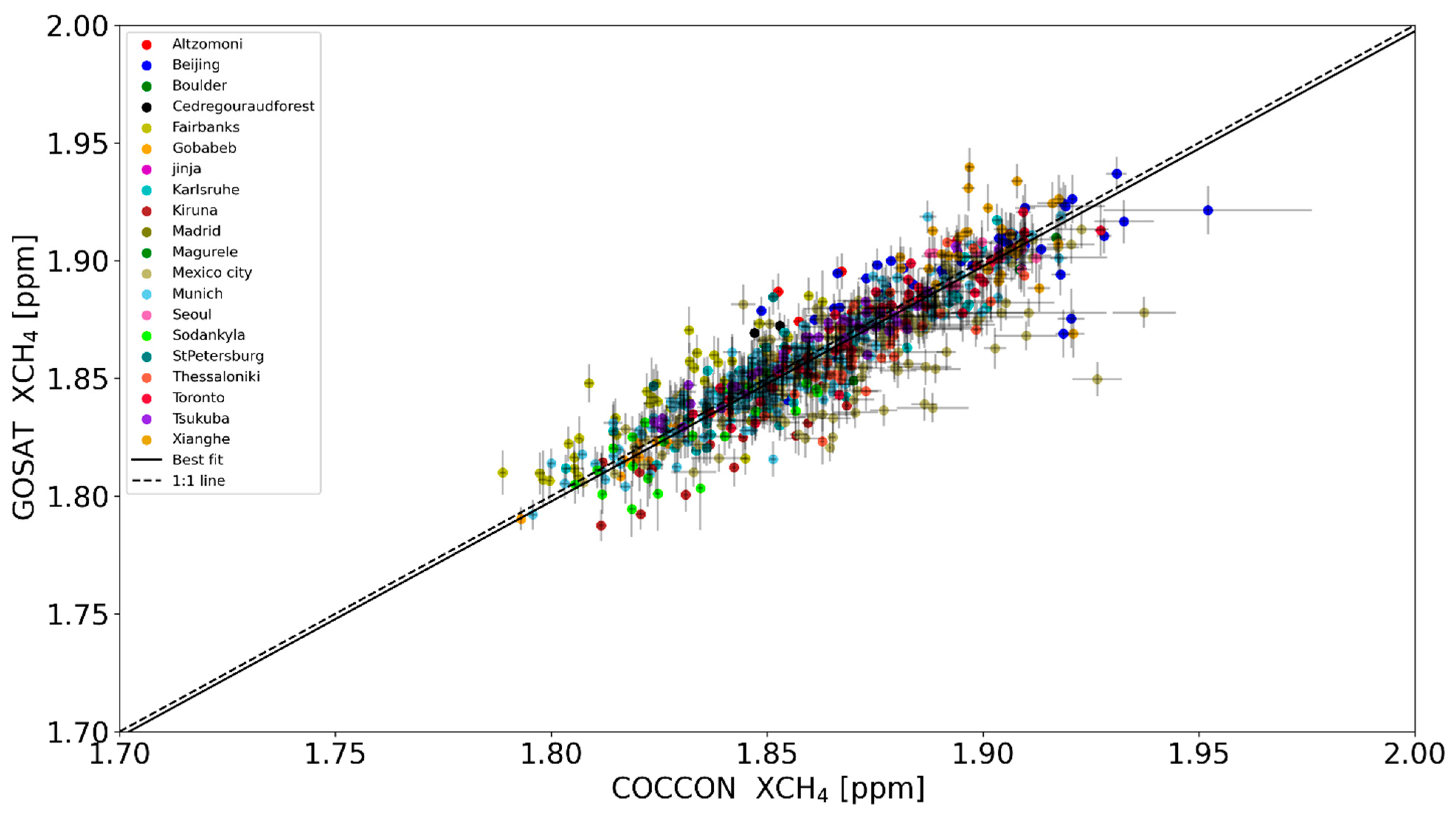
| Product ID | Stream | Version | In Operation from (Orbit #, Date) | In Operation Until (Orbit #, Date) |
|---|---|---|---|---|
| L2_CO and L2_CH4 | RPRO | 02.04.00 | 2818, 2018-04-30 | 24779, 2022-07-25 |
| OFFL | 02.04.00 02.05.00 02.06.00 | 24655, 2022-07-17 28031, 2023-03-12 31705, 2023-11-26 | 28030, 2023-03-12 31704, 2023-11-26 35777, 2024-09-07 |
| Site | Lat (°N) | No. | S5P bc XCH4 | S5P std XCH4 | ||||||
|---|---|---|---|---|---|---|---|---|---|---|
| SD | Corr | Rel Diff Bias (%) | Rel Diff SD (%) | SD | Corr | Rel Diff Bias (%) | Rel Diff SD (%) | |||
| EUREKA.PEARL | 80.1 | 21,638 | 0.9 | 0.78 | 0.08 | 0.61 | 0.8 | 0.73 | −0.65 | 0.76 |
| KIRUNA | 67.8 | 14,566 | 0.8 | 0.68 | −0.58 | 0.87 | 0.8 | 0.67 | −1.65 | 0.91 |
| SODANKYLA FM122 | 67.4 | 1971 | 0.8 | 0.64 | −0.22 | 0.78 | 0.8 | 0.58 | −1.27 | 0.86 |
| SODANKYLA KT039 | 67.4 | 5580 | 0.7 | 0.17 | −0.24 | 1.03 | 0.7 | 0.10 | −1.40 | 1.07 |
| FAIRBANKS.AK | 64.9 | 39,684 | 0.9 | 0.67 | 0.55 | 0.96 | 0.9 | 0.64 | −0.45 | 1.01 |
| ST.PETERSBURG 0 | 59.9 | 685 | 0.9 | 0.24 | 0.00 | 0.68 | 0.7 | 0.20 | −0.61 | 0.85 |
| ST.PETERSBURG 4 | 59.9 | 2706 | 0.9 | 0.33 | −0.01 | 1.02 | 0.8 | 0.33 | −0.85 | 1.10 |
| SVERDLOVSK | 56.8 | 282 | 0.3 | 0.70 | 0.39 | 0.96 | 0.3 | 0.75 | −0.76 | 0.99 |
| KARLSRUHE | 49.1 | 12,463 | 1.0 | 0.85 | −0.08 | 0.60 | 0.9 | 0.83 | −0.65 | 0.66 |
| MUNICH.TUM 116 | 48.3 | 446 | 0.1 | 0.06 | 0.31 | 0.41 | 0.3 | 0.07 | −0.18 | 0.18 |
| MUNICH.TUM 061 | 48.2 | 81,325 | 0.9 | 0.83 | 0.06 | 0.73 | 0.9 | 0.81 | −0.57 | 0.78 |
| MUNICH.TUM 086 | 48.1 | 235 | 47.0 | −0.01 | −0.25 | 0.06 | 3.1 | 0.07 | −0.60 | 0.06 |
| MUNICH.TUM 115 | 48.1 | 310 | 18.3 | 0.14 | 0.30 | 0.57 | 4.8 | 0.94 | −0.46 | 0.46 |
| MUNICH.TUM 117 | 48.0 | 550 | 0.6 | 0.78 | 0.70 | 0.15 | 1.3 | 0.38 | −0.11 | 0.14 |
| MAGURELE | 44.2 | 1722 | 0.7 | 0.75 | 0.17 | 0.66 | 0.7 | 0.74 | −0.24 | 0.69 |
| TORONTO.TAO | 43.7 | 53,837 | 0.8 | 0.86 | −0.14 | 0.67 | 0.8 | 0.85 | −0.70 | 0.71 |
| THESSALONIKI | 40.6 | 9714 | 1.0 | 0.85 | 0.35 | 0.52 | 1.0 | 0.84 | 0.00 | 0.54 |
| MADRID 53 | 40.5 | 796 | 1.1 | 0.66 | 0.57 | 0.29 | 1.0 | 0.70 | 0.45 | 0.28 |
| MADRID 85 | 40.5 | 667 | 1.1 | 0.58 | 0.12 | 0.42 | 1.1 | 0.67 | 0.03 | 0.37 |
| MADRID 81 | 40.5 | 744 | 1.1 | 0.57 | 0.51 | 0.30 | 1.0 | 0.67 | 0.39 | 0.28 |
| MADRID 69 | 40.4 | 453 | 3.2 | 0.34 | −0.42 | 1.43 | 3.5 | 0.16 | −0.48 | 1.51 |
| MADRID 52 | 40.4 | 804 | 1.1 | 0.76 | 0.50 | 0.29 | 1.2 | 0.66 | 0.43 | 0.34 |
| BOULDER.CO | 40.0 | 5199 | 0.9 | 0.85 | 0.35 | 0.48 | 0.8 | 0.86 | 0.13 | 0.50 |
| BEIJING | 39.9 | 5778 | 1.0 | 0.81 | 0.19 | 0.71 | 1.0 | 0.80 | −0.09 | 0.70 |
| XIANGHE | 39.8 | 4595 | 0.7 | 0.82 | 0.36 | 0.49 | 0.8 | 0.84 | 0.18 | 0.42 |
| SEOUL 2 | 37.5 | 1737 | 1.1 | 0.67 | 0.04 | 0.61 | 1.2 | 0.75 | −0.42 | 0.53 |
| SEOUL 4 | 37.5 | 2182 | 1.1 | 0.77 | 0.11 | 0.62 | 1.2 | 0.79 | −0.33 | 0.58 |
| TSUKUBA | 36.1 | 3108 | 0.9 | 0.86 | 0.19 | 0.50 | 0.9 | 0.89 | −0.27 | 0.46 |
| CEDRE.GOURAUD.FOREST | 33.4 | 689 | 0.6 | 0.31 | 0.16 | 0.56 | 0.6 | 0.36 | 0.33 | 0.56 |
| IZANA | 28.3 | 2508 | 0.8 | 0.75 | −0.24 | 0.95 | 0.8 | 0.59 | −0.84 | 1.16 |
| TECAMAC | 19.7 | 1159 | 1.1 | 0.56 | −0.06 | 0.67 | 1.0 | 0.46 | 0.01 | 0.74 |
| VALLEJO | 19.5 | 7789 | 0.9 | 0.56 | −0.18 | 1.04 | 0.9 | 0.54 | −0.37 | 1.08 |
| BOXO | 19.4 | 1358 | 1.7 | 0.50 | −0.77 | 1.27 | 1.6 | 0.49 | −0.84 | 1.29 |
| UNAM | 19.3 | 10,306 | 0.9 | 0.61 | −0.19 | 1.08 | 0.9 | 0.58 | −0.41 | 1.12 |
| ALTZOMONI | 19.1 | 52 | 1.1 | 0.43 | 0.49 | 1.00 | 1.1 | 0.40 | 0.18 | 1.04 |
| JINJA | 0.4 | 285 | 0.6 | 0.96 | −0.65 | 0.76 | 0.6 | 0.94 | −1.17 | 0.90 |
| GOBABEB | −23.6 | 9242 | 0.8 | 0.86 | 0.01 | 0.42 | 0.8 | 0.85 | 0.89 | 0.43 |
| ARRIVAL.HEIGHTS | −77.8 | 341 | 0.9 | 0.75 | 0.94 | 0.58 | 1.0 | 0.75 | −0.25 | 0.53 |
| Mean | -- | 2.62 | 0.61 | 0.09 | 0.68 | 1.12 | 0.61 | −0.36 | 0.70 | |
| Site | Lat (°N) | S5P XCO Avg | S5P XCO Dstrpdon | ||||||||
|---|---|---|---|---|---|---|---|---|---|---|---|
| No. | SD | Corr | Rel Diff Bias (%) | Rel Diff SD (%) | No. | SD | Corr | Rel Diff Bias (%) | Rel Diff SD (%) | ||
| EUREKA.PEARL | 80.1 | 40,789 | 0.8 | 0.97 | 5.86 | 3.99 | 37,845 | 0.8 | 0.90 | 5.58 | 7.49 |
| KIRUNA | 67.8 | 5165 | 0.9 | 0.96 | 0.32 | 5.23 | 3914 | 0.8 | 0.91 | 1.96 | 8.41 |
| SODANKYLA FM122 | 67.4 | 4916 | 0.8 | 0.95 | 4.76 | 5.28 | 3727 | 0.7 | 0.90 | 4.92 | 8.61 |
| SODANKYLA KT039 | 67.4 | 11,616 | 0.8 | 0.95 | −0.76 | 4.71 | 8927 | 0.8 | 0.87 | −0.01 | 7.61 |
| FAIRBANKS.AK | 64.9 | 86,248 | 1.0 | 0.93 | 2.35 | 4.71 | 71,632 | 1.0 | 0.90 | 2.68 | 6.77 |
| ST.PETERSBURG 0 | 59.9 | 761 | 1.2 | 0.77 | 3.39 | 3.14 | 608 | 0.8 | 0.80 | 2.10 | 3.20 |
| ST.PETERSBURG 4 | 59.9 | 4371 | 1.0 | 0.88 | 3.70 | 5.45 | 3745 | 0.8 | 0.84 | 3.83 | 7.22 |
| SVERDLOVSK | 56.8 | 684 | 0.8 | 0.92 | 5.28 | 3.46 | 592 | 0.8 | 0.80 | 6.76 | 5.51 |
| KARLSRUHE | 49.1 | 17,582 | 0.8 | 0.95 | 3.46 | 4.34 | 14,438 | 0.8 | 0.92 | 3.07 | 5.78 |
| MUNICH.TUM 116 | 48.3 | 1173 | 0.8 | 0.92 | 5.45 | 6.22 | 1171 | 0.8 | 0.88 | 6.82 | 6.93 |
| MUNICH.TUM 061 | 48.2 | 123,600 | 0.9 | 0.92 | 2.28 | 4.72 | 109,556 | 0.8 | 0.86 | 2.55 | 6.32 |
| MUNICH.TUM 086 | 48.1 | 922 | 0.6 | 0.84 | 6.58 | 6.71 | 920 | 0.6 | 0.82 | 6.55 | 7.64 |
| MUNICH.TUM 117 | 48.0 | 17 | nan | nan | −0.94 | 1.03 | 17 | nan | nan | −6.00 | 0.98 |
| MAGURELE | 44.2 | 2163 | 1.0 | 0.82 | 5.03 | 6.91 | 1876 | 0.9 | 0.78 | 5.33 | 7.99 |
| TORONTO.TAO | 43.7 | 82,213 | 0.9 | 0.94 | 5.57 | 4.69 | 73,012 | 0.8 | 0.86 | 6.10 | 8.04 |
| THESSALONIKI | 40.6 | 14,610 | 0.9 | 0.88 | 2.47 | 4.86 | 12,690 | 0.8 | 0.83 | 3.14 | 6.95 |
| MADRID 53 | 40.5 | 847 | 1.3 | 0.58 | 3.73 | 4.02 | 736 | 0.7 | 0.42 | 4.66 | 6.34 |
| MADRID 85 | 40.5 | 716 | 1.1 | 0.70 | 1.90 | 3.19 | 680 | 0.9 | 0.71 | 1.81 | 3.32 |
| MADRID 81 | 40.5 | 802 | 1.1 | 0.29 | 2.63 | 3.68 | 682 | 0.7 | 0.10 | 1.68 | 4.93 |
| MADRID 69 | 40.4 | 505 | 1.3 | 0.60 | 3.19 | 3.37 | 393 | 0.9 | 0.40 | 3.48 | 4.52 |
| MADRID 52 | 40.4 | 859 | 1.1 | 0.39 | 3.00 | 3.26 | 801 | 0.8 | 0.40 | 2.83 | 3.92 |
| BOULDER.CO | 40.0 | 6937 | 1.0 | 0.95 | 0.33 | 4.86 | 6397 | 1.0 | 0.86 | 1.58 | 8.42 |
| BEIJING | 39.9 | 8778 | 1.0 | 0.92 | 4.00 | 8.78 | 7788 | 1.0 | 0.89 | 4.36 | 9.51 |
| XIANGHE | 39.8 | 6405 | 1.0 | 0.97 | 1.30 | 5.00 | 5286 | 0.9 | 0.96 | 1.09 | 5.58 |
| SEOUL 2 | 37.5 | 2943 | 0.9 | 0.91 | 5.51 | 5.14 | 2703 | 0.9 | 0.87 | 6.34 | 6.63 |
| SEOUL 4 | 37.5 | 3714 | 1.0 | 0.94 | 5.79 | 4.48 | 3528 | 0.9 | 0.91 | 5.39 | 5.62 |
| TSUKUBA | 36.1 | 4904 | 1.0 | 0.96 | 3.34 | 3.84 | 4423 | 0.9 | 0.94 | 3.92 | 4.60 |
| CEDRE.GOURAUD.FOREST | 33.4 | 769 | 0.8 | 0.58 | −1.13 | 3.83 | 732 | 0.5 | 0.50 | −4.59 | 6.53 |
| IZANA | 28.3 | 17,068 | 0.6 | 0.41 | 6.94 | 18.84 | 15,421 | 0.3 | 0.27 | 7.49 | 33.69 |
| TECAMAC | 19.7 | 1729 | 1.2 | 0.66 | 0.68 | 10.46 | 803 | 1.3 | 0.67 | −0.86 | 10.09 |
| VALLEJO | 19.5 | 11,112 | 1.2 | 0.77 | −5.31 | 11.71 | 9004 | 1.1 | 0.84 | −0.53 | 10.91 |
| BOXO | 19.4 | 2248 | 1.1 | 0.83 | −2.09 | 10.94 | 1778 | 1.1 | 0.89 | 0.14 | 9.68 |
| UNAM | 19.3 | 15,258 | 1.3 | 0.71 | −6.59 | 12.04 | 12,368 | 1.0 | 0.81 | −0.06 | 11.24 |
| ALTZOMONI | 19.1 | 63 | 1.1 | 0.45 | 7.48 | 8.02 | 56 | 0.7 | 0.58 | 2.44 | 7.76 |
| JINJA | 0.4 | 853 | 0.8 | 0.90 | −6.22 | 9.15 | 702 | 0.8 | 0.91 | −3.02 | 9.88 |
| GOBABEB | −23.6 | 10,345 | 0.9 | 0.98 | 3.23 | 5.19 | 9769 | 0.9 | 0.96 | 2.98 | 6.45 |
| ARRIVAL.HEIGHTS | −77.8 | 598 | 0.6 | 0.74 | −3.48 | 6.46 | 515 | 0.7 | 0.45 | 3.74 | 8.16 |
| Mean | -- | 0.96 | 0.80 | 2.33 | 6.13 | -- | 0.83 | 0.76 | 2.95 | 7.84 | |
| Sites | Bias [ppm] | SD [ppm] | R2 | N |
|---|---|---|---|---|
| Altzomoni | 1.54 | 0.23 | 1 | 2 |
| Beijing | 1.53 | 1.53 | 1 | |
| Boulder | 0.74 | 0.46 | 0.91 | 8 |
| Boxo | −0.01 | −0.01 | 1 | |
| Cedre Gouraud Forest | 1.40 | 0.27 | 0.09 | 3 |
| Eureka | −0.06 | −0.06 | 1 | |
| Fairbanks | −0.51 | 0.81 | 0.98 | 14 |
| Gobabeb | 1.13 | 0.48 | 0.97 | 26 |
| Izana | 1.40 | 1.39 | 1 | |
| Jinja | −0.56 | −0.56 | 1 | |
| Karlsruhe | 0.40 | 0.79 | 0.96 | 36 |
| Kiruna | 0.26 | 0.47 | 0.99 | 22 |
| Magurele | −0.69 | 0.19 | 0.93 | 6 |
| Munich SN061 | 0.57 | 0.80 | 0.98 | 79 |
| Seoul | 2.29 | 0.12 | 0.99 | 3 |
| Sodankyla SN039 | 0.77 | 0.81 | 0.97 | 4 |
| Sodankyla SN122 | 2.21 | 2.21 | 1 | |
| St.Petersburg SN080 | −1.49 | 0.08 | 0.90 | 4 |
| St.Petersburg SN084 | 0.20 | 0.70 | 0.95 | 27 |
| Tecamac | −0.37 | 0.45 | 0.96 | 5 |
| Thessaloniki | 0.83 | 0.70 | 0.96 | 28 |
| Tsukuba | 1.59 | 1.59 | 1 | |
| Toronto | 0.21 | 0.82 | 0.98 | 78 |
| Unam | −1.06 | 1.08 | 0.93 | 52 |
| Vallejo | −0.60 | 1.02 | 0.78 | 19 |
| Xianghe | 3.11 | 0.54 | 1 | 2 |
| Station | Bias [ppm] (%) | SD [ppm] (%) | R2 | N |
|---|---|---|---|---|
| Altzomoni | 3.39 (0.83) | 1.00 (0.24) | 0.019 | 4 |
| Beijing | 1.43 (0.34) | 4.52 (1.09) | 0.608 | 44 |
| Boulder | −0.08 (−0.02) | 2.86 (0.69) | 0.753 | 6 |
| Cedregouraudforest | 6.01 (1.48) | 0.37 (0.09) | 1.000 | 2 |
| Fairbanks | −0.53 (−0.13) | 6.84 (1.67) | 0.723 | 50 |
| Gobabeb | 1.05 (0.26) | 2.20 (0.54) | 0.762 | 20 |
| Jinja | 0.55 (0.13) | 1 | ||
| Karlsruhe | 0.85 (0.21) | 7.07 (1.72) | 0.862 | 75 |
| Kiruna | −0.90 (−0.22) | 5.16 (1.27) | 0.691 | 15 |
| Madrid | −0.54 (−0.13) | 0.93 (0.23) | 0.967 | 3 |
| Magurele | −1.76 (−0.42) | 2.89 (0.69) | 0.873 | 4 |
| Mexico City | 0.35 (0.09) | 5.71 (1.39) | 0.832 | 168 |
| Munich | 0.49 (0.12) | 7.34 (1.79) | 0.903 | 178 |
| Seoul | 1.52 (0.37) | 4.08 (0.98) | 0.784 | 13 |
| Sodankyla | 1.12 (0.28) | 6.18 (1.53) | 0.872 | 22 |
| St. Petersburg | 3.08 (0.75) | 4.10 (1.00) | 0.359 | 9 |
| Thessaloniki | 0.55 (0.13) | 4.12 (1.00) | 0.552 | 33 |
| Toronto | 1.21 (0.29) | 7.13 (1.73) | 0.901 | 52 |
| Tsukuba | 0.82 (0.20) | 6.08 (1.48) | 0.875 | 39 |
| Xianghe | 2.62 (0.63) | 4.48 (1.08) | 0.540 | 28 |
| All data | 0.65 (0.16) | 2.01 (0.49) | 0.850 | 766 |
| Station | Bias [ppb] (%) | SD [ppb] (%) | R2 | N |
|---|---|---|---|---|
| Altzomoni | 21.93 (1.18) | 10.84 (0.58) | 0.019 | 4 |
| Beijing | 0.85 (0.04) | 29.55 (1.56) | 0.495 | 44 |
| Boulder | −1.30 (−0.07) | 22.26 (1.19) | 0.570 | 6 |
| Cedregouraudforest | 20.74 (1.12) | 3.34 (0.18) | 1.000 | 2 |
| Fairbanks | 12.27 (0.67) | 26.86 (1.47) | 0.667 | 50 |
| Gobabeb | −2.23 (0.12) | 16.08 (0.88) | 0.890 | 20 |
| Jinja | 5.78 (0.31) | 1 | ||
| Karlsruhe | −2.44 (−0.13) | 31.17 (1.68) | 0.838 | 75 |
| Kiruna | −18.55 (−1.00) | 23.98 (1.31) | 0.633 | 15 |
| Madrid | −8.34 (−0.45) | 9.79 (0.53) | 0.569 | 3 |
| Magurele | −8.40 (−0.44) | 17.01 (0.89) | 0.970 | 4 |
| Mexico City | −8.36 (−0.45) | 32.87 (1.76) | 0.603 | 168 |
| Munich | −1.07 (−0.06) | 36.56 (1.97) | 0.873 | 178 |
| Seoul | −0.97 (−0.05) | 16.32 (0.86) | 0.505 | 13 |
| Sodankyla | −8.08 (−0.44) | 24.68 (1.35) | 0.636 | 22 |
| St. Petersburg | 6.84 (0.37) | 20.73 (1.13) | 0.431 | 9 |
| Thessaloniki | −10.50 (−0.56) | 24.60 (1.31) | 0.670 | 33 |
| Toronto | −0.91 (−0.05) | 32.99 (1.76) | 0.890 | 52 |
| Tsukuba | 2.69 (0.14) | 28.55 (1.53) | 0.909 | 39 |
| Xianghe | 6.54 (0.34) | 18.51 (0.97) | 0.001 | 28 |
| All data | −2.32 (−0.12) | 13.52 (0.73) | 0.786 | 766 |
Disclaimer/Publisher’s Note: The statements, opinions and data contained in all publications are solely those of the individual author(s) and contributor(s) and not of MDPI and/or the editor(s). MDPI and/or the editor(s) disclaim responsibility for any injury to people or property resulting from any ideas, methods, instructions or products referred to in the content. |
© 2025 by the authors. Licensee MDPI, Basel, Switzerland. This article is an open access article distributed under the terms and conditions of the Creative Commons Attribution (CC BY) license (https://creativecommons.org/licenses/by/4.0/).
Share and Cite
Sha, M.K.; Das, S.; Frey, M.M.; Dubravica, D.; Alberti, C.; Baier, B.C.; Balis, D.; Bezanilla, A.; Blumenstock, T.; Boesch, H.; et al. Fiducial Reference Measurements for Greenhouse Gases (FRM4GHG): Validation of Satellite (Sentinel-5 Precursor, OCO-2, and GOSAT) Missions Using the COllaborative Carbon Column Observing Network (COCCON). Remote Sens. 2025, 17, 734. https://doi.org/10.3390/rs17050734
Sha MK, Das S, Frey MM, Dubravica D, Alberti C, Baier BC, Balis D, Bezanilla A, Blumenstock T, Boesch H, et al. Fiducial Reference Measurements for Greenhouse Gases (FRM4GHG): Validation of Satellite (Sentinel-5 Precursor, OCO-2, and GOSAT) Missions Using the COllaborative Carbon Column Observing Network (COCCON). Remote Sensing. 2025; 17(5):734. https://doi.org/10.3390/rs17050734
Chicago/Turabian StyleSha, Mahesh Kumar, Saswati Das, Matthias M. Frey, Darko Dubravica, Carlos Alberti, Bianca C. Baier, Dimitrios Balis, Alejandro Bezanilla, Thomas Blumenstock, Hartmut Boesch, and et al. 2025. "Fiducial Reference Measurements for Greenhouse Gases (FRM4GHG): Validation of Satellite (Sentinel-5 Precursor, OCO-2, and GOSAT) Missions Using the COllaborative Carbon Column Observing Network (COCCON)" Remote Sensing 17, no. 5: 734. https://doi.org/10.3390/rs17050734
APA StyleSha, M. K., Das, S., Frey, M. M., Dubravica, D., Alberti, C., Baier, B. C., Balis, D., Bezanilla, A., Blumenstock, T., Boesch, H., Cai, Z., Chen, J., Dandocsi, A., Mazière, M. D., Foka, S., García, O., Gillespie, L. D., Gribanov, K., Gross, J., ... Zhou, M. (2025). Fiducial Reference Measurements for Greenhouse Gases (FRM4GHG): Validation of Satellite (Sentinel-5 Precursor, OCO-2, and GOSAT) Missions Using the COllaborative Carbon Column Observing Network (COCCON). Remote Sensing, 17(5), 734. https://doi.org/10.3390/rs17050734






